Financial Resource Management Report: Sources, Costs, and Planning
VerifiedAdded on 2020/01/16
|15
|3490
|76
Report
AI Summary
This report provides a comprehensive overview of financial resource management, encompassing the identification and assessment of various funding sources, including retained earnings and bank loans. It delves into the implications of different financing options, evaluating their legal, control, and financial aspects. The report analyzes the costs associated with these sources, emphasizing the importance of financial planning for enhancing business capabilities and managing expenditures. It assesses the information needs of diverse decision-makers, such as employees, owners, creditors, and investors, and explains the impact of finance on financial statements. The report also analyzes budgets, calculates cost per unit using marginal and absorption costing, and assesses project viability through discounted cash flow and net present value analysis. Furthermore, it discusses financial statements, compares different formats, and interprets key financial ratios, providing a holistic understanding of financial management principles and practices.
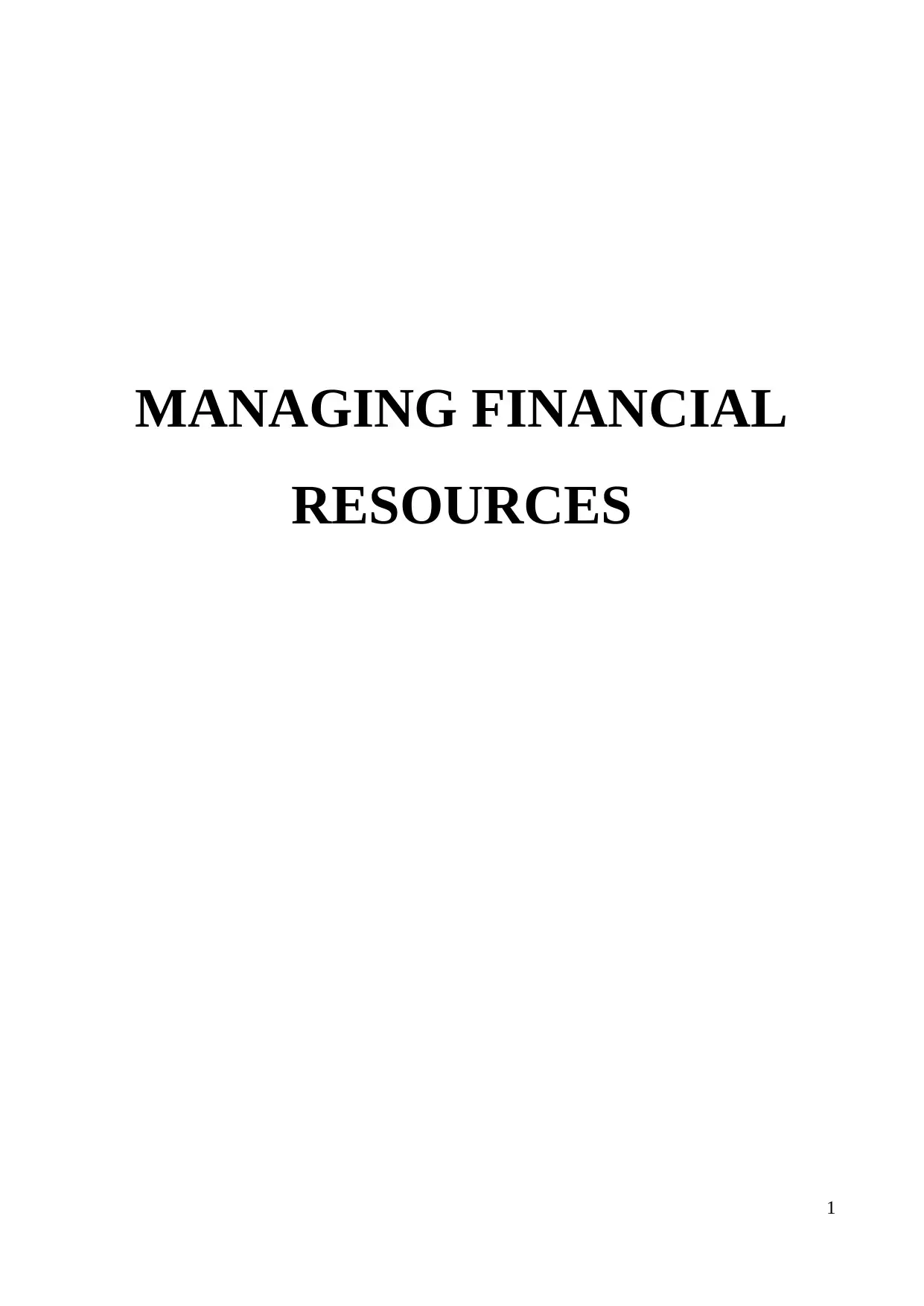
MANAGING FINANCIAL
RESOURCES
1
RESOURCES
1
Paraphrase This Document
Need a fresh take? Get an instant paraphrase of this document with our AI Paraphraser

Table of Contents
Introduction..........................................................................................................................................4
TASK 1.................................................................................................................................................4
1.1 Identify the sources of finance available to a business..............................................................4
1.2 Assess the implications of the different sources........................................................................4
1.3 Evaluate appropriate sources of finance for a business project.................................................4
Task 2....................................................................................................................................................5
2.1 Analyse the costs of different sources of finance.......................................................................5
2.2 Explain the importance of financial planning............................................................................5
2.3 Assess the information needs of different decision makers.......................................................5
2.4 Explain the impact of finance on the financial statements........................................................6
TASK 3.................................................................................................................................................7
3.1 Analyse budgets.........................................................................................................................7
3.2 Explain calculation of cost per unit and pricing decisions........................................................9
3.3 Assess the viability of the projects...........................................................................................11
TASK 4...............................................................................................................................................13
4.1 Discuss financial statements....................................................................................................13
4.2 Compare financial statements format......................................................................................14
4.3 Interpretation of ratios.............................................................................................................14
Conclusion..........................................................................................................................................15
References..........................................................................................................................................16
2
Introduction..........................................................................................................................................4
TASK 1.................................................................................................................................................4
1.1 Identify the sources of finance available to a business..............................................................4
1.2 Assess the implications of the different sources........................................................................4
1.3 Evaluate appropriate sources of finance for a business project.................................................4
Task 2....................................................................................................................................................5
2.1 Analyse the costs of different sources of finance.......................................................................5
2.2 Explain the importance of financial planning............................................................................5
2.3 Assess the information needs of different decision makers.......................................................5
2.4 Explain the impact of finance on the financial statements........................................................6
TASK 3.................................................................................................................................................7
3.1 Analyse budgets.........................................................................................................................7
3.2 Explain calculation of cost per unit and pricing decisions........................................................9
3.3 Assess the viability of the projects...........................................................................................11
TASK 4...............................................................................................................................................13
4.1 Discuss financial statements....................................................................................................13
4.2 Compare financial statements format......................................................................................14
4.3 Interpretation of ratios.............................................................................................................14
Conclusion..........................................................................................................................................15
References..........................................................................................................................................16
2
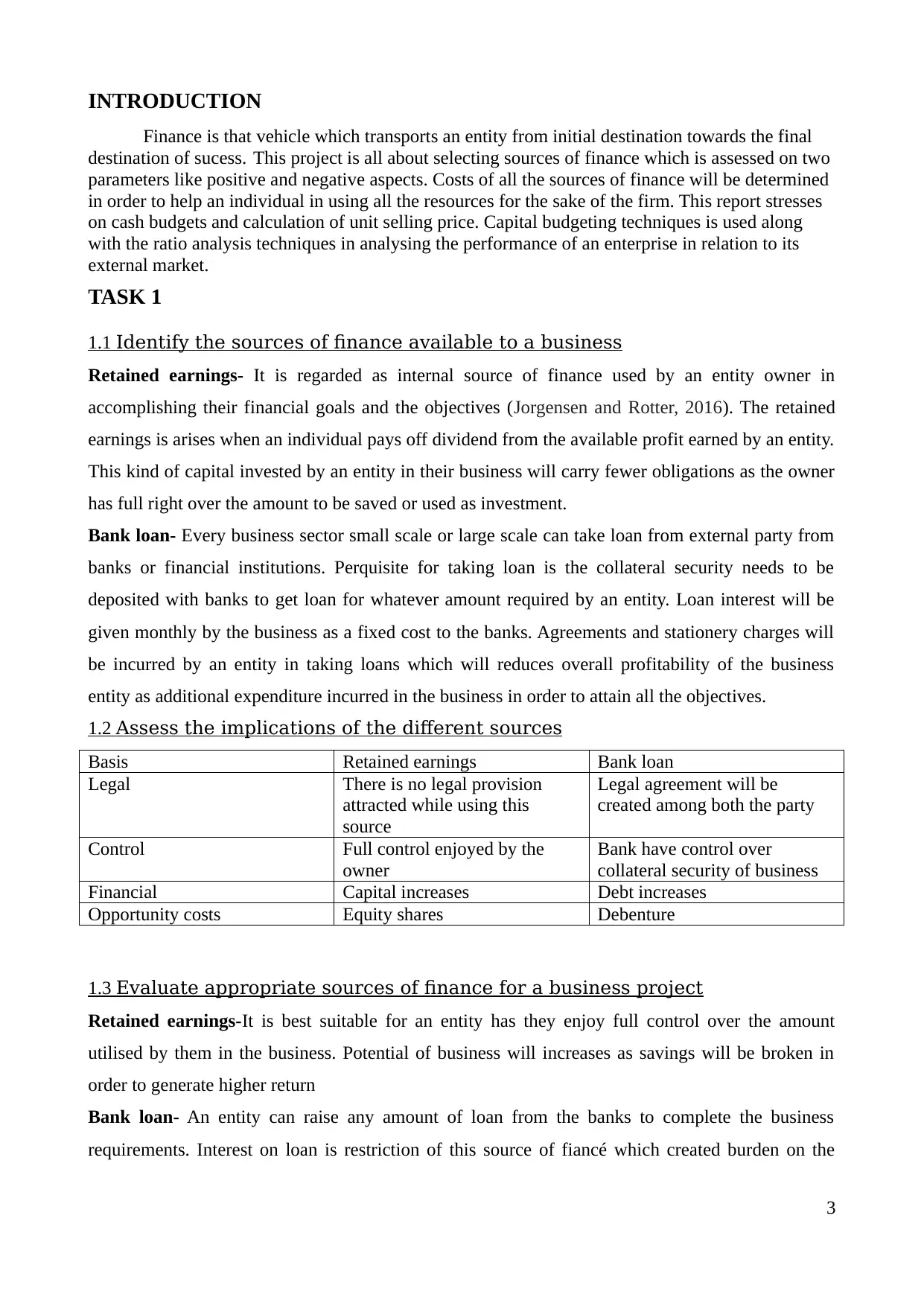
INTRODUCTION
Finance is that vehicle which transports an entity from initial destination towards the final
destination of sucess. This project is all about selecting sources of finance which is assessed on two
parameters like positive and negative aspects. Costs of all the sources of finance will be determined
in order to help an individual in using all the resources for the sake of the firm. This report stresses
on cash budgets and calculation of unit selling price. Capital budgeting techniques is used along
with the ratio analysis techniques in analysing the performance of an enterprise in relation to its
external market.
TASK 1
1.1 Identify the sources of finance available to a business
Retained earnings- It is regarded as internal source of finance used by an entity owner in
accomplishing their financial goals and the objectives (Jorgensen and Rotter, 2016). The retained
earnings is arises when an individual pays off dividend from the available profit earned by an entity.
This kind of capital invested by an entity in their business will carry fewer obligations as the owner
has full right over the amount to be saved or used as investment.
Bank loan- Every business sector small scale or large scale can take loan from external party from
banks or financial institutions. Perquisite for taking loan is the collateral security needs to be
deposited with banks to get loan for whatever amount required by an entity. Loan interest will be
given monthly by the business as a fixed cost to the banks. Agreements and stationery charges will
be incurred by an entity in taking loans which will reduces overall profitability of the business
entity as additional expenditure incurred in the business in order to attain all the objectives.
1.2 Assess the implications of the different sources
Basis Retained earnings Bank loan
Legal There is no legal provision
attracted while using this
source
Legal agreement will be
created among both the party
Control Full control enjoyed by the
owner
Bank have control over
collateral security of business
Financial Capital increases Debt increases
Opportunity costs Equity shares Debenture
1.3 Evaluate appropriate sources of finance for a business project
Retained earnings-It is best suitable for an entity has they enjoy full control over the amount
utilised by them in the business. Potential of business will increases as savings will be broken in
order to generate higher return
Bank loan- An entity can raise any amount of loan from the banks to complete the business
requirements. Interest on loan is restriction of this source of fiancé which created burden on the
3
Finance is that vehicle which transports an entity from initial destination towards the final
destination of sucess. This project is all about selecting sources of finance which is assessed on two
parameters like positive and negative aspects. Costs of all the sources of finance will be determined
in order to help an individual in using all the resources for the sake of the firm. This report stresses
on cash budgets and calculation of unit selling price. Capital budgeting techniques is used along
with the ratio analysis techniques in analysing the performance of an enterprise in relation to its
external market.
TASK 1
1.1 Identify the sources of finance available to a business
Retained earnings- It is regarded as internal source of finance used by an entity owner in
accomplishing their financial goals and the objectives (Jorgensen and Rotter, 2016). The retained
earnings is arises when an individual pays off dividend from the available profit earned by an entity.
This kind of capital invested by an entity in their business will carry fewer obligations as the owner
has full right over the amount to be saved or used as investment.
Bank loan- Every business sector small scale or large scale can take loan from external party from
banks or financial institutions. Perquisite for taking loan is the collateral security needs to be
deposited with banks to get loan for whatever amount required by an entity. Loan interest will be
given monthly by the business as a fixed cost to the banks. Agreements and stationery charges will
be incurred by an entity in taking loans which will reduces overall profitability of the business
entity as additional expenditure incurred in the business in order to attain all the objectives.
1.2 Assess the implications of the different sources
Basis Retained earnings Bank loan
Legal There is no legal provision
attracted while using this
source
Legal agreement will be
created among both the party
Control Full control enjoyed by the
owner
Bank have control over
collateral security of business
Financial Capital increases Debt increases
Opportunity costs Equity shares Debenture
1.3 Evaluate appropriate sources of finance for a business project
Retained earnings-It is best suitable for an entity has they enjoy full control over the amount
utilised by them in the business. Potential of business will increases as savings will be broken in
order to generate higher return
Bank loan- An entity can raise any amount of loan from the banks to complete the business
requirements. Interest on loan is restriction of this source of fiancé which created burden on the
3
⊘ This is a preview!⊘
Do you want full access?
Subscribe today to unlock all pages.

Trusted by 1+ million students worldwide
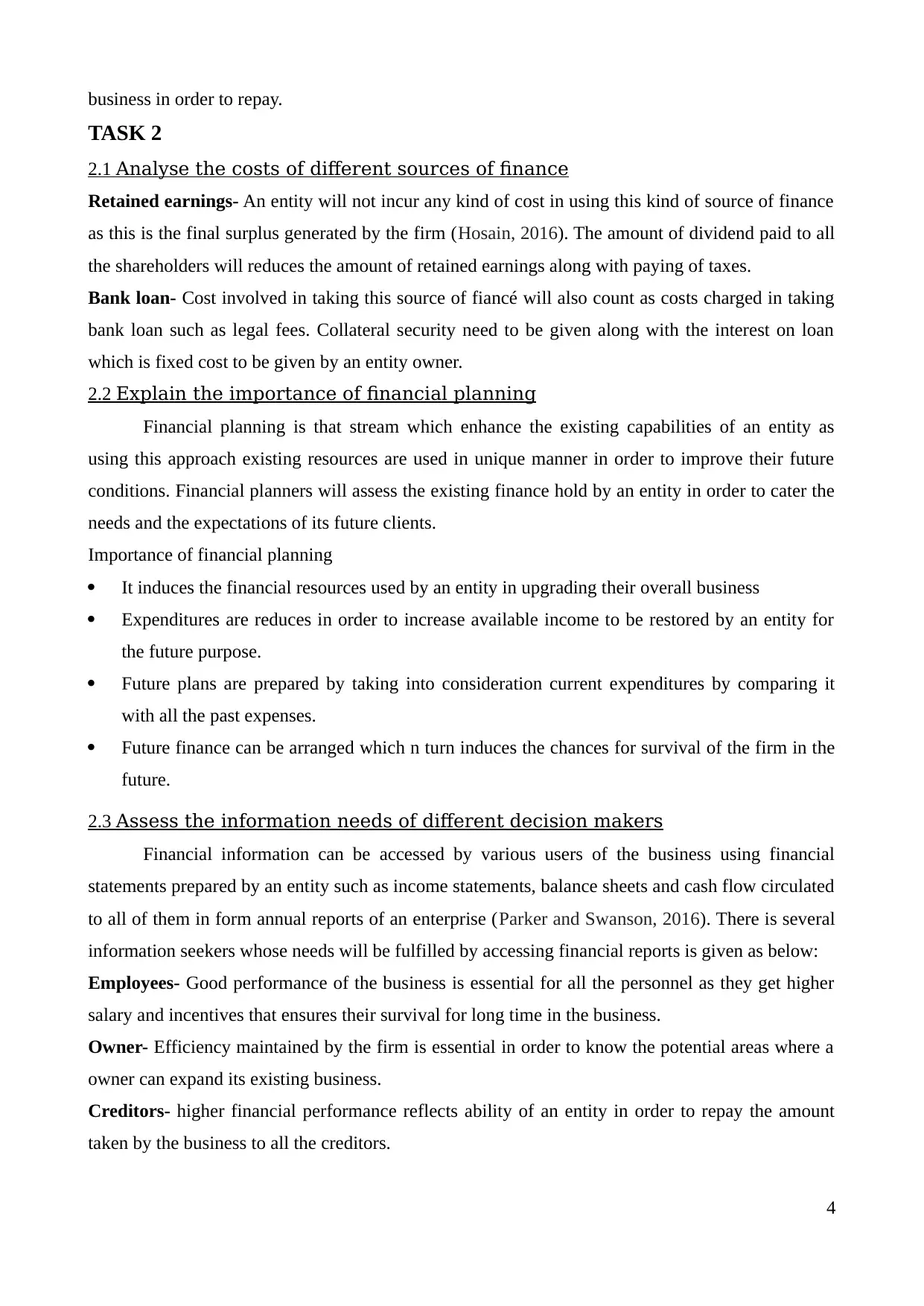
business in order to repay.
TASK 2
2.1 Analyse the costs of different sources of finance
Retained earnings- An entity will not incur any kind of cost in using this kind of source of finance
as this is the final surplus generated by the firm (Hosain, 2016). The amount of dividend paid to all
the shareholders will reduces the amount of retained earnings along with paying of taxes.
Bank loan- Cost involved in taking this source of fiancé will also count as costs charged in taking
bank loan such as legal fees. Collateral security need to be given along with the interest on loan
which is fixed cost to be given by an entity owner.
2.2 Explain the importance of financial planning
Financial planning is that stream which enhance the existing capabilities of an entity as
using this approach existing resources are used in unique manner in order to improve their future
conditions. Financial planners will assess the existing finance hold by an entity in order to cater the
needs and the expectations of its future clients.
Importance of financial planning
It induces the financial resources used by an entity in upgrading their overall business
Expenditures are reduces in order to increase available income to be restored by an entity for
the future purpose.
Future plans are prepared by taking into consideration current expenditures by comparing it
with all the past expenses.
Future finance can be arranged which n turn induces the chances for survival of the firm in the
future.
2.3 Assess the information needs of different decision makers
Financial information can be accessed by various users of the business using financial
statements prepared by an entity such as income statements, balance sheets and cash flow circulated
to all of them in form annual reports of an enterprise (Parker and Swanson, 2016). There is several
information seekers whose needs will be fulfilled by accessing financial reports is given as below:
Employees- Good performance of the business is essential for all the personnel as they get higher
salary and incentives that ensures their survival for long time in the business.
Owner- Efficiency maintained by the firm is essential in order to know the potential areas where a
owner can expand its existing business.
Creditors- higher financial performance reflects ability of an entity in order to repay the amount
taken by the business to all the creditors.
4
TASK 2
2.1 Analyse the costs of different sources of finance
Retained earnings- An entity will not incur any kind of cost in using this kind of source of finance
as this is the final surplus generated by the firm (Hosain, 2016). The amount of dividend paid to all
the shareholders will reduces the amount of retained earnings along with paying of taxes.
Bank loan- Cost involved in taking this source of fiancé will also count as costs charged in taking
bank loan such as legal fees. Collateral security need to be given along with the interest on loan
which is fixed cost to be given by an entity owner.
2.2 Explain the importance of financial planning
Financial planning is that stream which enhance the existing capabilities of an entity as
using this approach existing resources are used in unique manner in order to improve their future
conditions. Financial planners will assess the existing finance hold by an entity in order to cater the
needs and the expectations of its future clients.
Importance of financial planning
It induces the financial resources used by an entity in upgrading their overall business
Expenditures are reduces in order to increase available income to be restored by an entity for
the future purpose.
Future plans are prepared by taking into consideration current expenditures by comparing it
with all the past expenses.
Future finance can be arranged which n turn induces the chances for survival of the firm in the
future.
2.3 Assess the information needs of different decision makers
Financial information can be accessed by various users of the business using financial
statements prepared by an entity such as income statements, balance sheets and cash flow circulated
to all of them in form annual reports of an enterprise (Parker and Swanson, 2016). There is several
information seekers whose needs will be fulfilled by accessing financial reports is given as below:
Employees- Good performance of the business is essential for all the personnel as they get higher
salary and incentives that ensures their survival for long time in the business.
Owner- Efficiency maintained by the firm is essential in order to know the potential areas where a
owner can expand its existing business.
Creditors- higher financial performance reflects ability of an entity in order to repay the amount
taken by the business to all the creditors.
4
Paraphrase This Document
Need a fresh take? Get an instant paraphrase of this document with our AI Paraphraser
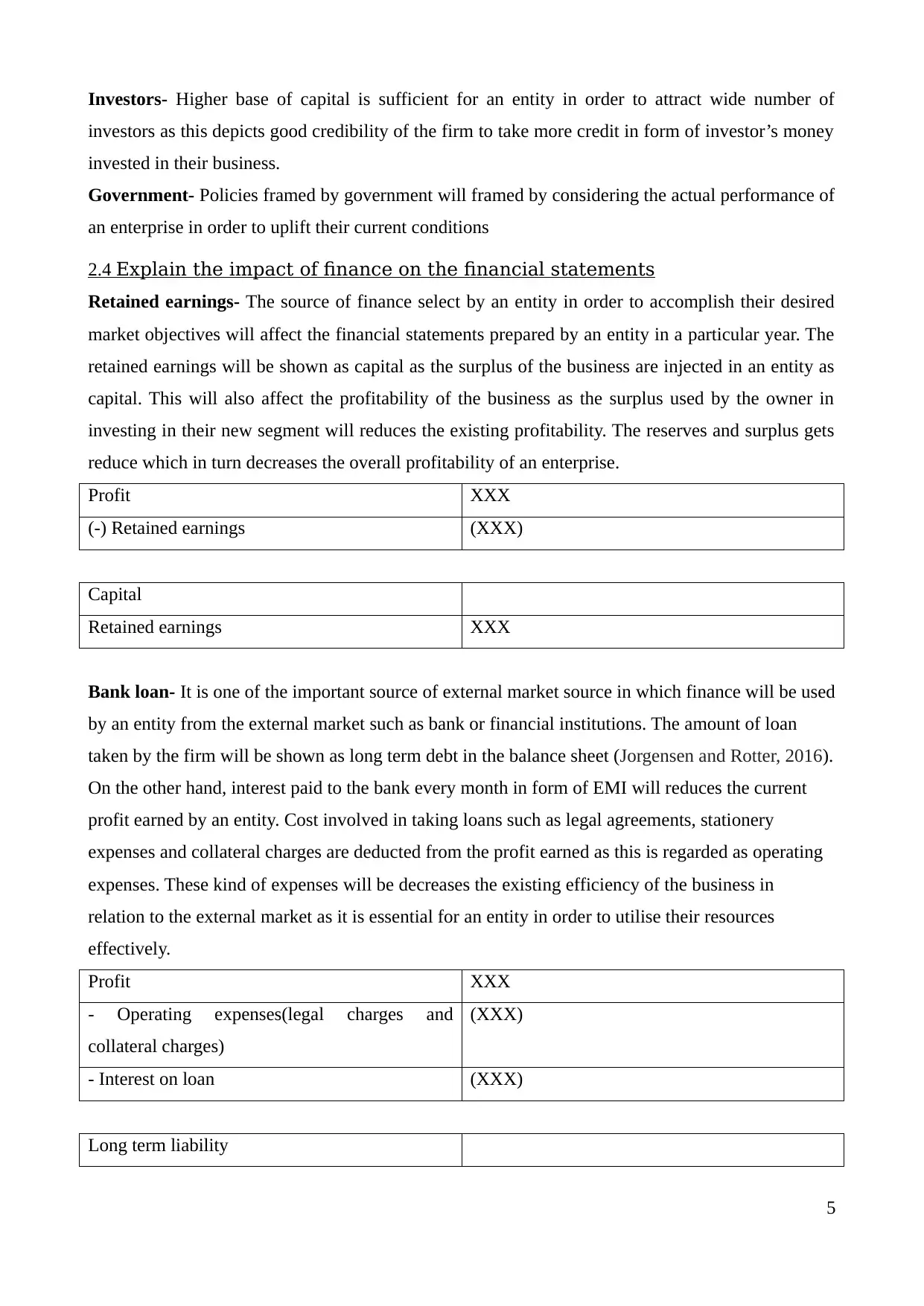
Investors- Higher base of capital is sufficient for an entity in order to attract wide number of
investors as this depicts good credibility of the firm to take more credit in form of investor’s money
invested in their business.
Government- Policies framed by government will framed by considering the actual performance of
an enterprise in order to uplift their current conditions
2.4 Explain the impact of finance on the financial statements
Retained earnings- The source of finance select by an entity in order to accomplish their desired
market objectives will affect the financial statements prepared by an entity in a particular year. The
retained earnings will be shown as capital as the surplus of the business are injected in an entity as
capital. This will also affect the profitability of the business as the surplus used by the owner in
investing in their new segment will reduces the existing profitability. The reserves and surplus gets
reduce which in turn decreases the overall profitability of an enterprise.
Profit XXX
(-) Retained earnings (XXX)
Capital
Retained earnings XXX
Bank loan- It is one of the important source of external market source in which finance will be used
by an entity from the external market such as bank or financial institutions. The amount of loan
taken by the firm will be shown as long term debt in the balance sheet (Jorgensen and Rotter, 2016).
On the other hand, interest paid to the bank every month in form of EMI will reduces the current
profit earned by an entity. Cost involved in taking loans such as legal agreements, stationery
expenses and collateral charges are deducted from the profit earned as this is regarded as operating
expenses. These kind of expenses will be decreases the existing efficiency of the business in
relation to the external market as it is essential for an entity in order to utilise their resources
effectively.
Profit XXX
- Operating expenses(legal charges and
collateral charges)
(XXX)
- Interest on loan (XXX)
Long term liability
5
investors as this depicts good credibility of the firm to take more credit in form of investor’s money
invested in their business.
Government- Policies framed by government will framed by considering the actual performance of
an enterprise in order to uplift their current conditions
2.4 Explain the impact of finance on the financial statements
Retained earnings- The source of finance select by an entity in order to accomplish their desired
market objectives will affect the financial statements prepared by an entity in a particular year. The
retained earnings will be shown as capital as the surplus of the business are injected in an entity as
capital. This will also affect the profitability of the business as the surplus used by the owner in
investing in their new segment will reduces the existing profitability. The reserves and surplus gets
reduce which in turn decreases the overall profitability of an enterprise.
Profit XXX
(-) Retained earnings (XXX)
Capital
Retained earnings XXX
Bank loan- It is one of the important source of external market source in which finance will be used
by an entity from the external market such as bank or financial institutions. The amount of loan
taken by the firm will be shown as long term debt in the balance sheet (Jorgensen and Rotter, 2016).
On the other hand, interest paid to the bank every month in form of EMI will reduces the current
profit earned by an entity. Cost involved in taking loans such as legal agreements, stationery
expenses and collateral charges are deducted from the profit earned as this is regarded as operating
expenses. These kind of expenses will be decreases the existing efficiency of the business in
relation to the external market as it is essential for an entity in order to utilise their resources
effectively.
Profit XXX
- Operating expenses(legal charges and
collateral charges)
(XXX)
- Interest on loan (XXX)
Long term liability
5
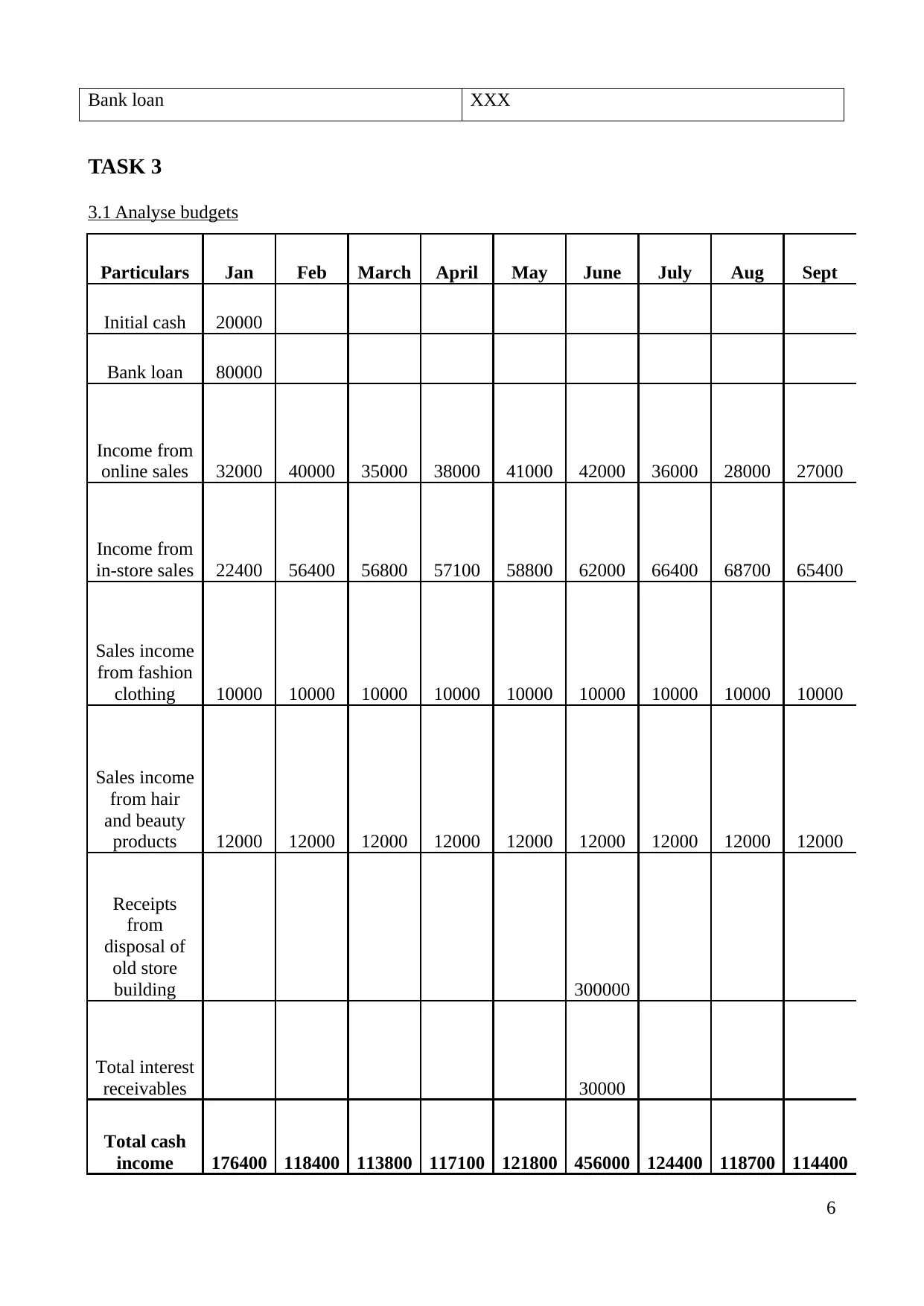
Bank loan XXX
TASK 3
3.1 Analyse budgets
Particulars Jan Feb March April May June July Aug Sept
Initial cash 20000
Bank loan 80000
Income from
online sales 32000 40000 35000 38000 41000 42000 36000 28000 27000
Income from
in-store sales 22400 56400 56800 57100 58800 62000 66400 68700 65400
Sales income
from fashion
clothing 10000 10000 10000 10000 10000 10000 10000 10000 10000
Sales income
from hair
and beauty
products 12000 12000 12000 12000 12000 12000 12000 12000 12000
Receipts
from
disposal of
old store
building 300000
Total interest
receivables 30000
Total cash
income 176400 118400 113800 117100 121800 456000 124400 118700 114400
6
TASK 3
3.1 Analyse budgets
Particulars Jan Feb March April May June July Aug Sept
Initial cash 20000
Bank loan 80000
Income from
online sales 32000 40000 35000 38000 41000 42000 36000 28000 27000
Income from
in-store sales 22400 56400 56800 57100 58800 62000 66400 68700 65400
Sales income
from fashion
clothing 10000 10000 10000 10000 10000 10000 10000 10000 10000
Sales income
from hair
and beauty
products 12000 12000 12000 12000 12000 12000 12000 12000 12000
Receipts
from
disposal of
old store
building 300000
Total interest
receivables 30000
Total cash
income 176400 118400 113800 117100 121800 456000 124400 118700 114400
6
⊘ This is a preview!⊘
Do you want full access?
Subscribe today to unlock all pages.

Trusted by 1+ million students worldwide
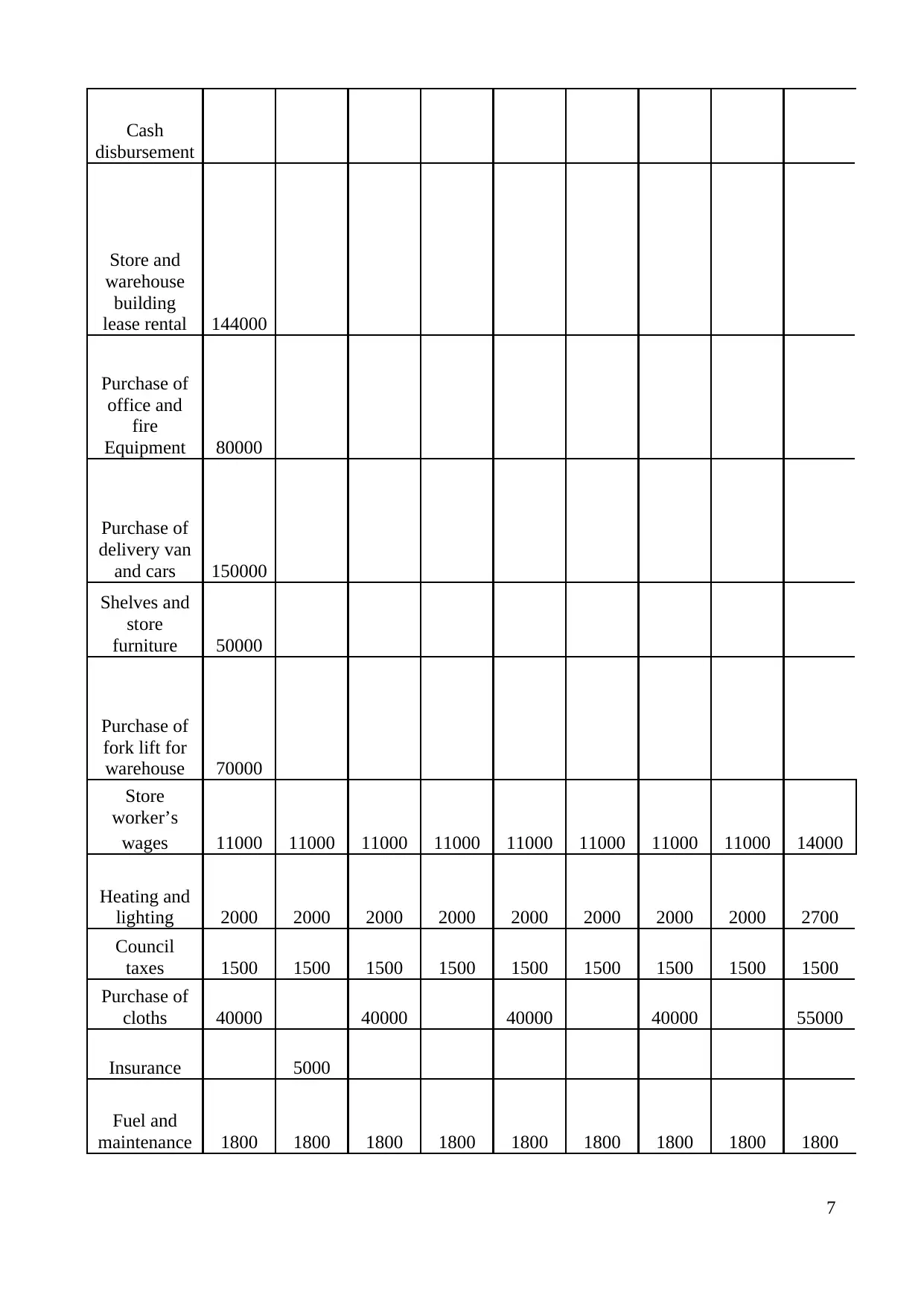
Cash
disbursement
Store and
warehouse
building
lease rental 144000
Purchase of
office and
fire
Equipment 80000
Purchase of
delivery van
and cars 150000
Shelves and
store
furniture 50000
Purchase of
fork lift for
warehouse 70000
Store
worker’s
11000 11000 11000 11000 11000 11000 11000 11000 14000wages
Heating and
lighting 2000 2000 2000 2000 2000 2000 2000 2000 2700
Council
taxes 1500 1500 1500 1500 1500 1500 1500 1500 1500
Purchase of
cloths 40000 40000 40000 40000 55000
Insurance 5000
Fuel and
maintenance 1800 1800 1800 1800 1800 1800 1800 1800 1800
7
disbursement
Store and
warehouse
building
lease rental 144000
Purchase of
office and
fire
Equipment 80000
Purchase of
delivery van
and cars 150000
Shelves and
store
furniture 50000
Purchase of
fork lift for
warehouse 70000
Store
worker’s
11000 11000 11000 11000 11000 11000 11000 11000 14000wages
Heating and
lighting 2000 2000 2000 2000 2000 2000 2000 2000 2700
Council
taxes 1500 1500 1500 1500 1500 1500 1500 1500 1500
Purchase of
cloths 40000 40000 40000 40000 55000
Insurance 5000
Fuel and
maintenance 1800 1800 1800 1800 1800 1800 1800 1800 1800
7
Paraphrase This Document
Need a fresh take? Get an instant paraphrase of this document with our AI Paraphraser

Total cash
outflow 550300 21300 56300 16300 56300 16300 56300 16300 75000
Net cash
balance
-
373900 97100 57500 100800 65500 439700 68100 102400 39400
Opening
cash balance 0
-
373900
-
276800
-
219300
-
118500 -53000 386700 454800 557200
Closing
cash
balance
-
373900
-
276800
-
219300
-
118500 -53000 386700 454800 557200 596600
Cash budget- cash movement will be ascertained by an individual by determining their available
cash in order to pay off all the liabilities currently incurred by the business. The cash inflows will be
ascertained in order to reduces or eliminate the less important expenses incurred by an entity. With
the help of these statements prioritisation will be done by an entity in which less important and
important expenses are extracted in order to eliminate all the expenditures currently incurred in the
business which is suppressing the skills and the capabilities of an individual.
The above cash flow statements initially show negative cash flows due to higher imposition
of payments and cash outflows in an entity (Kostova and Nell, 2016). In the initial phase, the less
expertise of an individual will increases their beginning expenditures which are not suitable for the
business entity. In the next month the negative cash flows doesn’t get changed into positive one but
in the absolute manner the amount of negative cash flows gets reduced. After first quarter that is
initial four months an entity stared earning positive cash flows due to it’s comfortless in the
business environment. This kind of comfort is very helpful for the business that leads to the
reduction of all the expenditures. The reduction of expenses will enhances the ability of the business
in relation to its competitors.
3.2 Explain calculation of cost per unit and pricing decisions
Particulars Cost (£)
Variable cost
Direct material 15000
Direct labor 12000
8
outflow 550300 21300 56300 16300 56300 16300 56300 16300 75000
Net cash
balance
-
373900 97100 57500 100800 65500 439700 68100 102400 39400
Opening
cash balance 0
-
373900
-
276800
-
219300
-
118500 -53000 386700 454800 557200
Closing
cash
balance
-
373900
-
276800
-
219300
-
118500 -53000 386700 454800 557200 596600
Cash budget- cash movement will be ascertained by an individual by determining their available
cash in order to pay off all the liabilities currently incurred by the business. The cash inflows will be
ascertained in order to reduces or eliminate the less important expenses incurred by an entity. With
the help of these statements prioritisation will be done by an entity in which less important and
important expenses are extracted in order to eliminate all the expenditures currently incurred in the
business which is suppressing the skills and the capabilities of an individual.
The above cash flow statements initially show negative cash flows due to higher imposition
of payments and cash outflows in an entity (Kostova and Nell, 2016). In the initial phase, the less
expertise of an individual will increases their beginning expenditures which are not suitable for the
business entity. In the next month the negative cash flows doesn’t get changed into positive one but
in the absolute manner the amount of negative cash flows gets reduced. After first quarter that is
initial four months an entity stared earning positive cash flows due to it’s comfortless in the
business environment. This kind of comfort is very helpful for the business that leads to the
reduction of all the expenditures. The reduction of expenses will enhances the ability of the business
in relation to its competitors.
3.2 Explain calculation of cost per unit and pricing decisions
Particulars Cost (£)
Variable cost
Direct material 15000
Direct labor 12000
8
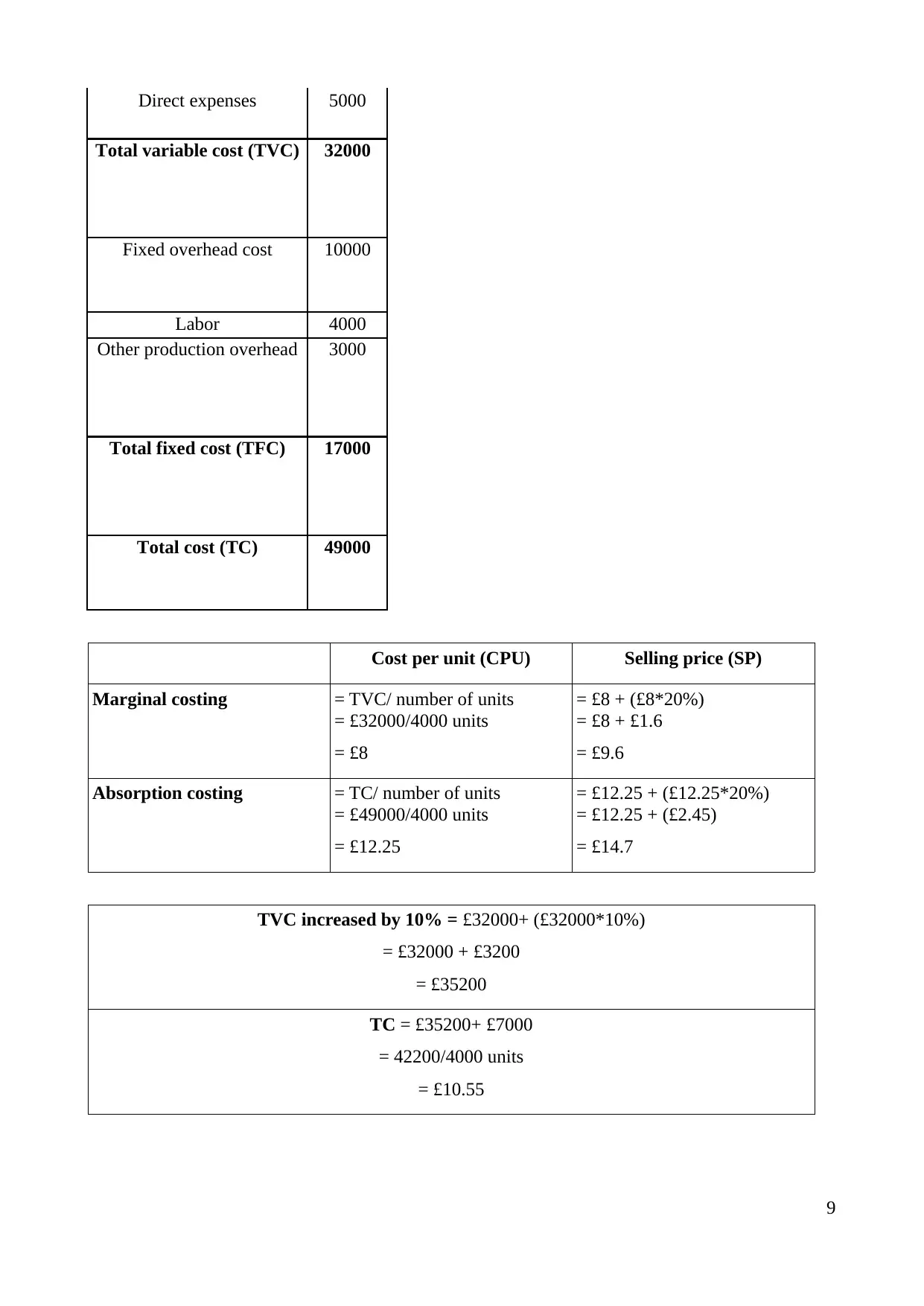
Direct expenses 5000
Total variable cost (TVC) 32000
Fixed overhead cost 10000
Labor 4000
Other production overhead 3000
Total fixed cost (TFC) 17000
Total cost (TC) 49000
Cost per unit (CPU) Selling price (SP)
Marginal costing = TVC/ number of units
= £32000/4000 units
= £8
= £8 + (£8*20%)
= £8 + £1.6
= £9.6
Absorption costing = TC/ number of units
= £49000/4000 units
= £12.25
= £12.25 + (£12.25*20%)
= £12.25 + (£2.45)
= £14.7
TVC increased by 10% = £32000+ (£32000*10%)
= £32000 + £3200
= £35200
TC = £35200+ £7000
= 42200/4000 units
= £10.55
9
Total variable cost (TVC) 32000
Fixed overhead cost 10000
Labor 4000
Other production overhead 3000
Total fixed cost (TFC) 17000
Total cost (TC) 49000
Cost per unit (CPU) Selling price (SP)
Marginal costing = TVC/ number of units
= £32000/4000 units
= £8
= £8 + (£8*20%)
= £8 + £1.6
= £9.6
Absorption costing = TC/ number of units
= £49000/4000 units
= £12.25
= £12.25 + (£12.25*20%)
= £12.25 + (£2.45)
= £14.7
TVC increased by 10% = £32000+ (£32000*10%)
= £32000 + £3200
= £35200
TC = £35200+ £7000
= 42200/4000 units
= £10.55
9
⊘ This is a preview!⊘
Do you want full access?
Subscribe today to unlock all pages.

Trusted by 1+ million students worldwide
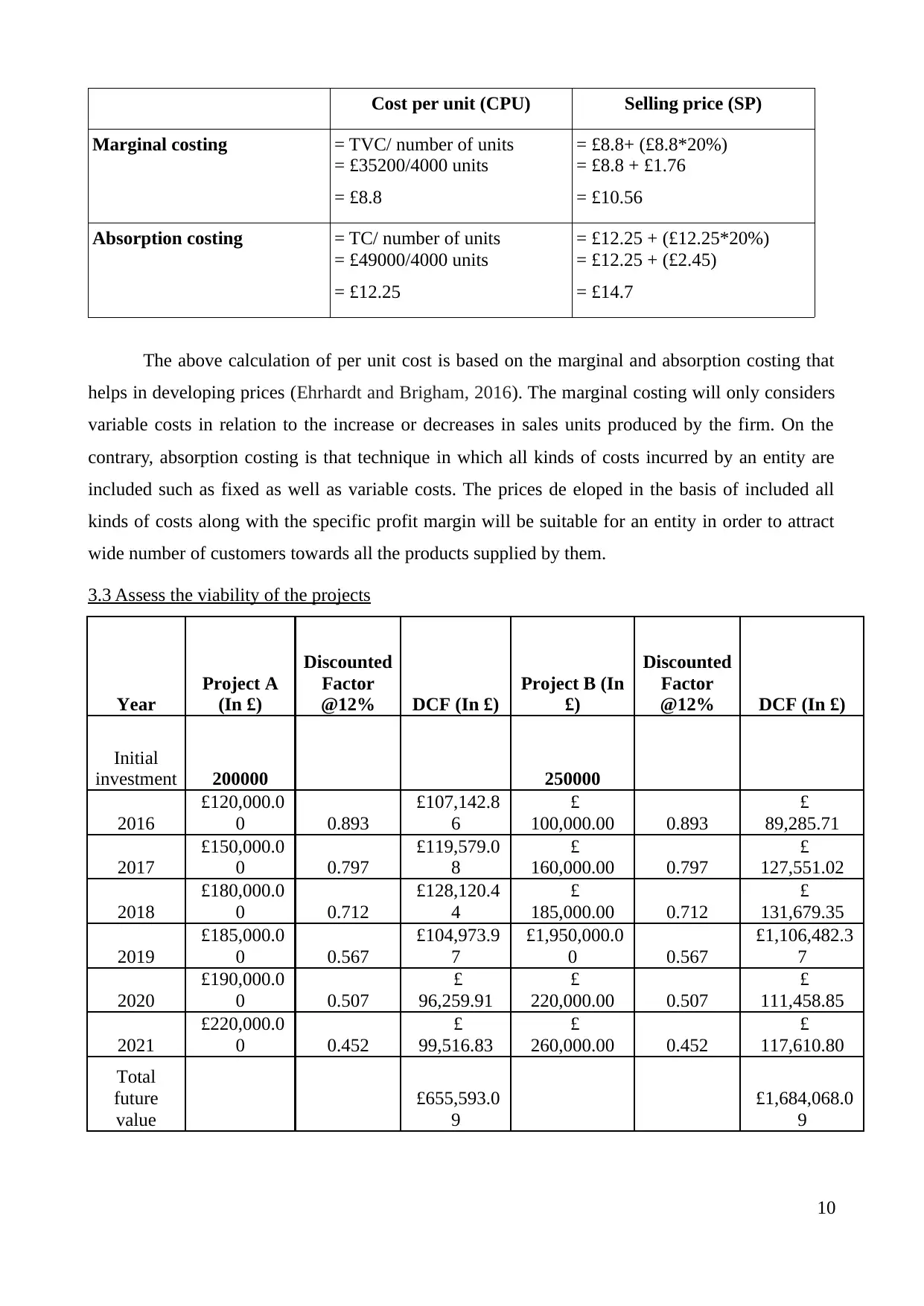
Cost per unit (CPU) Selling price (SP)
Marginal costing = TVC/ number of units
= £35200/4000 units
= £8.8
= £8.8+ (£8.8*20%)
= £8.8 + £1.76
= £10.56
Absorption costing = TC/ number of units
= £49000/4000 units
= £12.25
= £12.25 + (£12.25*20%)
= £12.25 + (£2.45)
= £14.7
The above calculation of per unit cost is based on the marginal and absorption costing that
helps in developing prices (Ehrhardt and Brigham, 2016). The marginal costing will only considers
variable costs in relation to the increase or decreases in sales units produced by the firm. On the
contrary, absorption costing is that technique in which all kinds of costs incurred by an entity are
included such as fixed as well as variable costs. The prices de eloped in the basis of included all
kinds of costs along with the specific profit margin will be suitable for an entity in order to attract
wide number of customers towards all the products supplied by them.
3.3 Assess the viability of the projects
Year
Project A
(In £)
Discounted
Factor
@12% DCF (In £)
Project B (In
£)
Discounted
Factor
@12% DCF (In £)
Initial
investment 200000 250000
2016
£120,000.0
0 0.893
£107,142.8
6
£
100,000.00 0.893
£
89,285.71
2017
£150,000.0
0 0.797
£119,579.0
8
£
160,000.00 0.797
£
127,551.02
2018
£180,000.0
0 0.712
£128,120.4
4
£
185,000.00 0.712
£
131,679.35
2019
£185,000.0
0 0.567
£104,973.9
7
£1,950,000.0
0 0.567
£1,106,482.3
7
2020
£190,000.0
0 0.507
£
96,259.91
£
220,000.00 0.507
£
111,458.85
2021
£220,000.0
0 0.452
£
99,516.83
£
260,000.00 0.452
£
117,610.80
Total
future
value
£655,593.0
9
£1,684,068.0
9
10
Marginal costing = TVC/ number of units
= £35200/4000 units
= £8.8
= £8.8+ (£8.8*20%)
= £8.8 + £1.76
= £10.56
Absorption costing = TC/ number of units
= £49000/4000 units
= £12.25
= £12.25 + (£12.25*20%)
= £12.25 + (£2.45)
= £14.7
The above calculation of per unit cost is based on the marginal and absorption costing that
helps in developing prices (Ehrhardt and Brigham, 2016). The marginal costing will only considers
variable costs in relation to the increase or decreases in sales units produced by the firm. On the
contrary, absorption costing is that technique in which all kinds of costs incurred by an entity are
included such as fixed as well as variable costs. The prices de eloped in the basis of included all
kinds of costs along with the specific profit margin will be suitable for an entity in order to attract
wide number of customers towards all the products supplied by them.
3.3 Assess the viability of the projects
Year
Project A
(In £)
Discounted
Factor
@12% DCF (In £)
Project B (In
£)
Discounted
Factor
@12% DCF (In £)
Initial
investment 200000 250000
2016
£120,000.0
0 0.893
£107,142.8
6
£
100,000.00 0.893
£
89,285.71
2017
£150,000.0
0 0.797
£119,579.0
8
£
160,000.00 0.797
£
127,551.02
2018
£180,000.0
0 0.712
£128,120.4
4
£
185,000.00 0.712
£
131,679.35
2019
£185,000.0
0 0.567
£104,973.9
7
£1,950,000.0
0 0.567
£1,106,482.3
7
2020
£190,000.0
0 0.507
£
96,259.91
£
220,000.00 0.507
£
111,458.85
2021
£220,000.0
0 0.452
£
99,516.83
£
260,000.00 0.452
£
117,610.80
Total
future
value
£655,593.0
9
£1,684,068.0
9
10
Paraphrase This Document
Need a fresh take? Get an instant paraphrase of this document with our AI Paraphraser
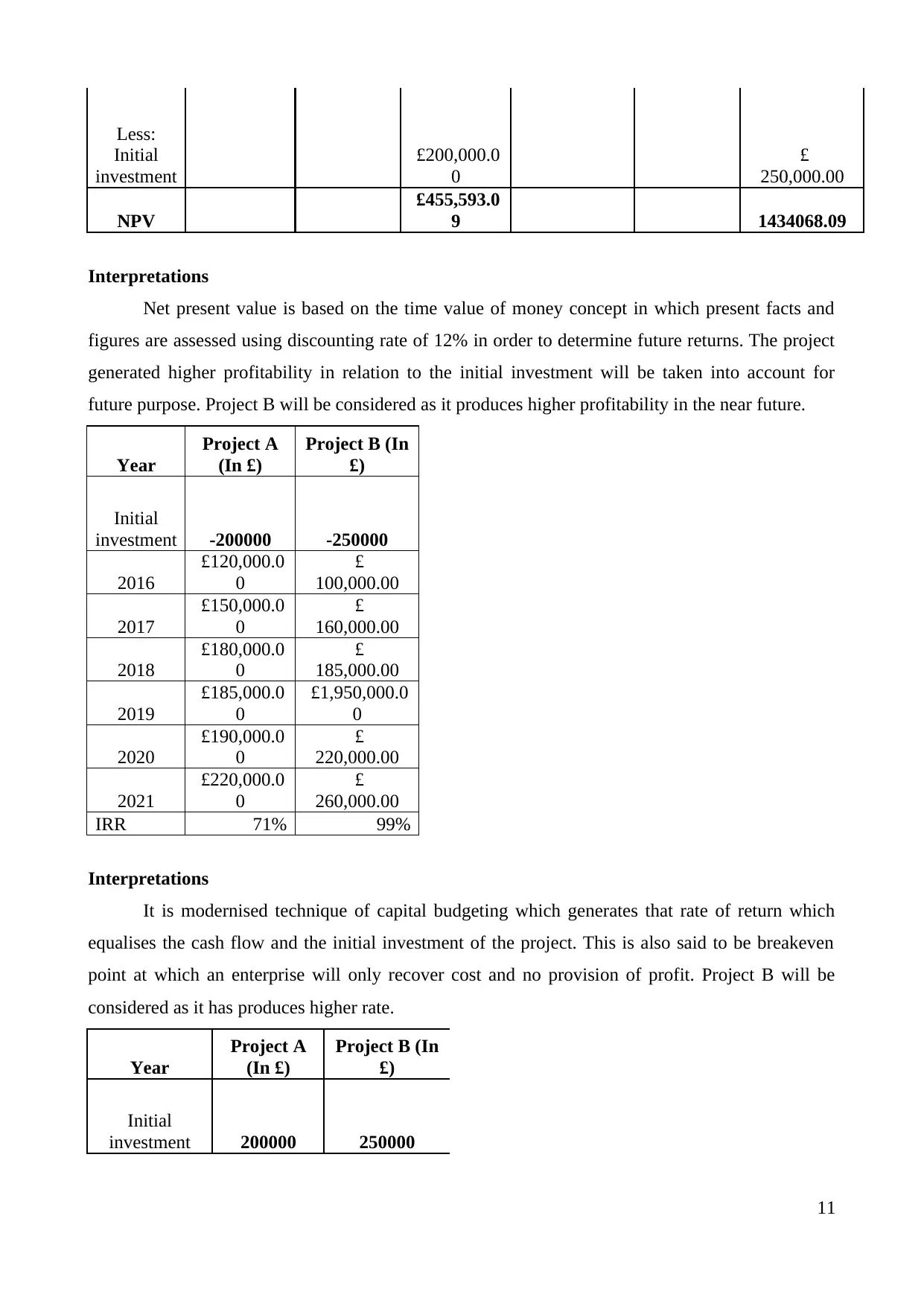
Less:
Initial
investment
£200,000.0
0
£
250,000.00
NPV
£455,593.0
9 1434068.09
Interpretations
Net present value is based on the time value of money concept in which present facts and
figures are assessed using discounting rate of 12% in order to determine future returns. The project
generated higher profitability in relation to the initial investment will be taken into account for
future purpose. Project B will be considered as it produces higher profitability in the near future.
Year
Project A
(In £)
Project B (In
£)
Initial
investment -200000 -250000
2016
£120,000.0
0
£
100,000.00
2017
£150,000.0
0
£
160,000.00
2018
£180,000.0
0
£
185,000.00
2019
£185,000.0
0
£1,950,000.0
0
2020
£190,000.0
0
£
220,000.00
2021
£220,000.0
0
£
260,000.00
IRR 71% 99%
Interpretations
It is modernised technique of capital budgeting which generates that rate of return which
equalises the cash flow and the initial investment of the project. This is also said to be breakeven
point at which an enterprise will only recover cost and no provision of profit. Project B will be
considered as it has produces higher rate.
Year
Project A
(In £)
Project B (In
£)
Initial
investment 200000 250000
11
Initial
investment
£200,000.0
0
£
250,000.00
NPV
£455,593.0
9 1434068.09
Interpretations
Net present value is based on the time value of money concept in which present facts and
figures are assessed using discounting rate of 12% in order to determine future returns. The project
generated higher profitability in relation to the initial investment will be taken into account for
future purpose. Project B will be considered as it produces higher profitability in the near future.
Year
Project A
(In £)
Project B (In
£)
Initial
investment -200000 -250000
2016
£120,000.0
0
£
100,000.00
2017
£150,000.0
0
£
160,000.00
2018
£180,000.0
0
£
185,000.00
2019
£185,000.0
0
£1,950,000.0
0
2020
£190,000.0
0
£
220,000.00
2021
£220,000.0
0
£
260,000.00
IRR 71% 99%
Interpretations
It is modernised technique of capital budgeting which generates that rate of return which
equalises the cash flow and the initial investment of the project. This is also said to be breakeven
point at which an enterprise will only recover cost and no provision of profit. Project B will be
considered as it has produces higher rate.
Year
Project A
(In £)
Project B (In
£)
Initial
investment 200000 250000
11
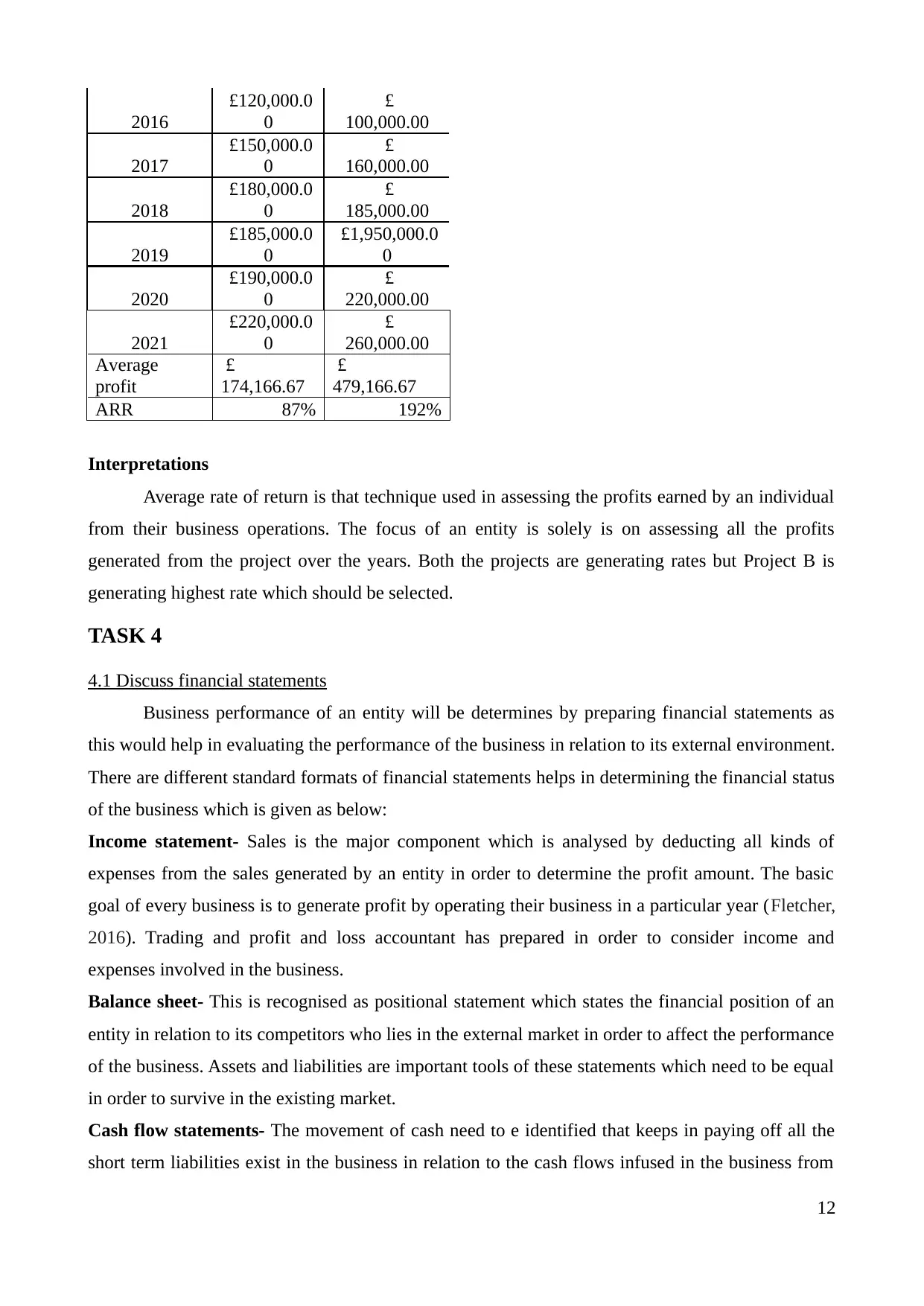
2016
£120,000.0
0
£
100,000.00
2017
£150,000.0
0
£
160,000.00
2018
£180,000.0
0
£
185,000.00
2019
£185,000.0
0
£1,950,000.0
0
2020
£190,000.0
0
£
220,000.00
2021
£220,000.0
0
£
260,000.00
Average
profit
£
174,166.67
£
479,166.67
ARR 87% 192%
Interpretations
Average rate of return is that technique used in assessing the profits earned by an individual
from their business operations. The focus of an entity is solely is on assessing all the profits
generated from the project over the years. Both the projects are generating rates but Project B is
generating highest rate which should be selected.
TASK 4
4.1 Discuss financial statements
Business performance of an entity will be determines by preparing financial statements as
this would help in evaluating the performance of the business in relation to its external environment.
There are different standard formats of financial statements helps in determining the financial status
of the business which is given as below:
Income statement- Sales is the major component which is analysed by deducting all kinds of
expenses from the sales generated by an entity in order to determine the profit amount. The basic
goal of every business is to generate profit by operating their business in a particular year (Fletcher,
2016). Trading and profit and loss accountant has prepared in order to consider income and
expenses involved in the business.
Balance sheet- This is recognised as positional statement which states the financial position of an
entity in relation to its competitors who lies in the external market in order to affect the performance
of the business. Assets and liabilities are important tools of these statements which need to be equal
in order to survive in the existing market.
Cash flow statements- The movement of cash need to e identified that keeps in paying off all the
short term liabilities exist in the business in relation to the cash flows infused in the business from
12
£120,000.0
0
£
100,000.00
2017
£150,000.0
0
£
160,000.00
2018
£180,000.0
0
£
185,000.00
2019
£185,000.0
0
£1,950,000.0
0
2020
£190,000.0
0
£
220,000.00
2021
£220,000.0
0
£
260,000.00
Average
profit
£
174,166.67
£
479,166.67
ARR 87% 192%
Interpretations
Average rate of return is that technique used in assessing the profits earned by an individual
from their business operations. The focus of an entity is solely is on assessing all the profits
generated from the project over the years. Both the projects are generating rates but Project B is
generating highest rate which should be selected.
TASK 4
4.1 Discuss financial statements
Business performance of an entity will be determines by preparing financial statements as
this would help in evaluating the performance of the business in relation to its external environment.
There are different standard formats of financial statements helps in determining the financial status
of the business which is given as below:
Income statement- Sales is the major component which is analysed by deducting all kinds of
expenses from the sales generated by an entity in order to determine the profit amount. The basic
goal of every business is to generate profit by operating their business in a particular year (Fletcher,
2016). Trading and profit and loss accountant has prepared in order to consider income and
expenses involved in the business.
Balance sheet- This is recognised as positional statement which states the financial position of an
entity in relation to its competitors who lies in the external market in order to affect the performance
of the business. Assets and liabilities are important tools of these statements which need to be equal
in order to survive in the existing market.
Cash flow statements- The movement of cash need to e identified that keeps in paying off all the
short term liabilities exist in the business in relation to the cash flows infused in the business from
12
⊘ This is a preview!⊘
Do you want full access?
Subscribe today to unlock all pages.

Trusted by 1+ million students worldwide
1 out of 15
Related Documents
Your All-in-One AI-Powered Toolkit for Academic Success.
+13062052269
info@desklib.com
Available 24*7 on WhatsApp / Email
![[object Object]](/_next/static/media/star-bottom.7253800d.svg)
Unlock your academic potential
Copyright © 2020–2025 A2Z Services. All Rights Reserved. Developed and managed by ZUCOL.





